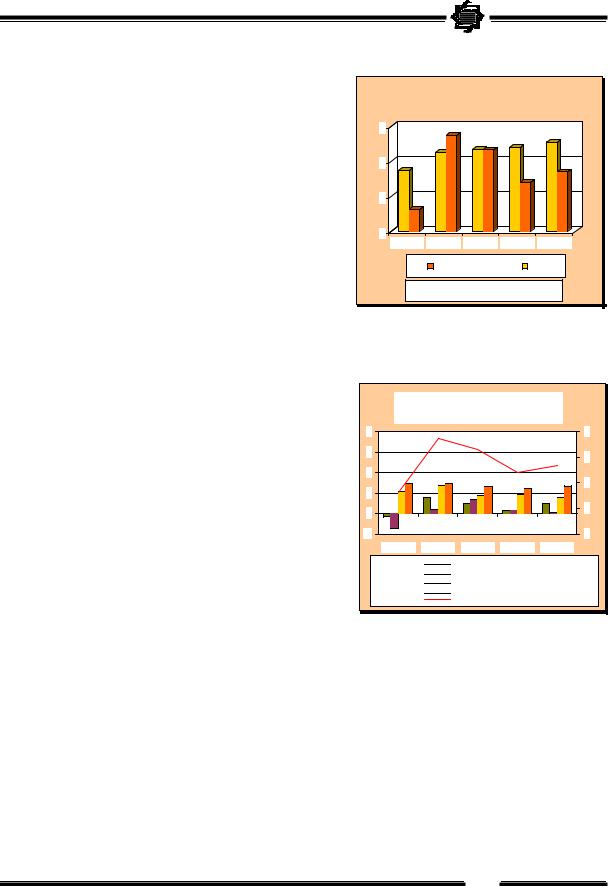
СТАТИСТИКА 1 / Банк Ирана / Annual1384e
.pdf
Annual Review
1384
(2005/06)
CENTRAL BANK OF THE ISLAMIC REPUBLIC OF IRAN
(BANK MARKAZI JOMHOURI ISLAMI IRAN)

Annual Review
1384
(2005/06)
CENTRAL BANK OF THE ISLAMIC REPUBLIC OF IRAN
(BANK MARKAZI JOMHOURI ISLAMI IRAN)
__ |
Negligible fraction |
.. |
Figures not available |
…Statistical data unavailable
The figure is not a significant decimal fraction
Figures are preliminary
SPrevious figures now revised
θCalculation of percentage change is not possible
More than 500 percent increase
zFigure has been rounded
{Percentage change has been calculated from round figures
FYDP |
Five Year Development Plan |
MCC |
Money and Credit Council |
Introduction .................................................................................................................................................. |
5 |
National Income ........................................................................................................................................... |
7 |
Agriculture ................................................................................................................................................... |
7 |
Energy …….................................................................................................................................................. |
9 |
Manufacturing and Mining .......................................................................................................................... |
10 |
Construction and Housing ............................................................................................................................ |
12 |
Transportation ............................................................................................................................................... |
14 |
Population and Employment ........................................................................................................................ |
15 |
Government Budget and Finance ................................................................................................................. |
17 |
Balance of Payments .................................................................................................................................... |
20 |
Money and Banking ..................................................................................................................................... |
22 |
Capital Market ............................................................................................................................................. |
26 |
Price Trends ................................................................................................................................................. |
28 |
List of Appendix Tables ............................................................................................................................... |
30 |
In the Name of God,
The Compassionate, The Merciful

Introduction
Despite regional tensions, Iranian economy performed relatively well in the first year of the 4th Development Plan, 1384 (2005/06). In line with the economic policies drawn up in the Fourth Plan on the basis of constructive interaction with the global economy as well as the expansion of competitiveness, the government attempted to prepare the ground for economic growth and development through further participation of the non-public sector, enhancement of productivity, facilitation of trade regulations, establishment of fiscal discipline, implementation of decentralization policies, utilization of the Oil Stabilization Fund (OSF) and reduction of disparities among various regions of the country. The continued price rise of oil in international market also played a pivotal role in creating growth environment in this year.
Achieving a sustainable long-term economic growth, in particular provision of economic justice, as the main priority of the Government, requires price stability and curbing inflation. To this end, the Central Bank attempted
5

to control liquidity while financing the required resources of the manufacturing units. Nonetheless, a 34.3 percent liquidity growth was recorded for the review year, 10.3 percentage points above the target set in the Plan (24 percent). This was due to the fact that the target set for selling the Central Bank participation papers was not met.
Despite high liquidity growth in 2005/06, the inflation rate fell beyond expectation by 3.1 percentage points to 12.1 percent as compared with 1383 (2004/05). This was mostly due to surge in imports, reduction in tariffs, recession in the housing sector as well as control of inflationary expectations owing to stability of the exchange market.
6

National Income (1)
During the first year of the 4th Development Plan, 2005/06, real GDP growth strengthened and grew by 5.4 percent at constant 1997/98 prices, showing 0.6 percentage point rise as compared with the previous year. Non-oil GDP with 0.9 percentage point increase registered a 6.0 percent growth. Increase in GDP growth was largely attributable to the acceleration of agricultural activities following improvement in climatic conditions, and growth rate of construction activities which was due to increase in government development expenditures in construction sector and growth in completed buildings in urban areas by private sector.
In the review year, the value-added of “manufacturing and mining”, “agriculture”, “services” and “oil” sectors grew by 6.7, 7.1, 5.6 and 0.6 percent, respectively.
Private and public consumption growth were estimated at 6.6 and 5.4 percent at constant 1997/98 prices. These figures indicated 6.4 percent of growth in total consumption and a higher share of public consumption when compared with the 8.6 and 1.3 percent of the previous year.
Moreover, gross fixed capital formation comprising investment in machinery and construction enjoyed 5.8 percent growth in the review year, as compared to the previous year. Investment in machinery and construction posted growth of 6.4 and 4.7 percent, respectively.
GDP Growth Rate (1) |
|
(percent) |
|
8 |
|
6 |
|
4 |
|
2 |
|
2001/02 2002/03 2003/04 2004/05 2005/06 |
|
Performance |
Plan |
1-The plan target for 2005/06 is based on |
|
2002/03 constant prices. |
|
Contribution to GDP Growth
|
|
(percent) |
|
|
8 |
|
|
|
8 |
6 |
|
|
|
6 |
|
|
|
|
|
4 |
|
|
|
4 |
2 |
|
|
|
|
|
|
|
|
|
0 |
|
|
|
2 |
|
|
|
|
|
-2 |
|
|
|
0 |
2001/02 |
2002/03 |
2003/04 |
2004/05 |
2005/06 |

 Agriculture
Agriculture
 Oil
Oil

 Manufacturing & mining
Manufacturing & mining

 Services
Services
GDP growth (right scale)
Agriculture
The farming year of 1383/84 (2004/05-2005/06) experienced a benign climatic condition and a welldistributed rainfall. According to the data drawn by the Ministry of Agriculture Jihad, this brought the production of farming and horticultural produce to a total of 82.5 million tons, up by 7.1 percent as compared with the previous farming year. Production of farming crops was estimated at 67.8 million tons and that of horticultural
__________________________________________________________________________________________
(1) Data related to “national accounts” are preliminary.
7

produce at 14.7 million tons, showing 5.9 and 12.2 percent growth as compared to the previous year. Moreover, total production of cereals (wheat, rice (paddy), barley and corn) reached 23.3 million tons, showing 1.3 million tons (6 percent) rise as compared to the previous year.
Implementation of wheat self-sufficiency plan and the government support policy for guaranteed purchase of wheat at a price higher than international prices together with a relative improvement in its guaranteed purchase price in comparison with other competitive crops (such as barley) led to an increasing growth in the wheat production in the recent years. According to the preliminary data released by the Ministry of Agriculture Jihad, wheat production was 15 million tons, up by 432 thousand tons, as compared to the previous year. According to the available data, the amount of wheat purchased from farmers was 10,935 thousand tons, showing 2.2 percent reduction, as compared to the year before.
Moreover, the preliminary data released by the Ministry of Agriculture Jihad in 2005/06 indicates a rise in the total livestock produce (red meat, poultry, milk, eggs and honey) by 7.2 percent to 10 million tons as compared to the previous year. In addition, the production of farming-industrial crops (cotton, sugar beet, oil seeds, sugar cane and tobacco), with 7.1 percent growth, amounted to 12.5 million tons.
The outstanding facilities extended by banks and non-bank credit institutions to the agriculture sector grew by 34.9 percent in 2005/06 to reach Rls. 114,708.9 billion, as compared to 2004/05. Out of these facilities, 44.3 percent was paid by commercial banks and 55.7 percent by Bank Keshavarzi (Agriculture Bank). In this year, Bank Keshavarzi paid Rls. 49,894 billion facilities to the agriculture sector, showing 36 percent rise as compared to the previous year. Out of total facilities, Rls. 41,031.5 billion (82.2 percent) was paid from non-budgetary resources and the remainder from the budget law notes, administered funds, and contracts, showing 33.3 and 50.1 percent growth, as compared with the previous year, respectively.
8

Energy
In 2005, the world primary energy (1) consumption amounted to 10.5 billion tons oil equivalent, up by 2.4 percent compared to the year before. Of the total world primary energy consumption, 9.9 billion tons oil equivalent was the share of non-OPEC countries, and that of the OPEC member countries was 0.6 billion tons. In the review year, oil had the lion’s share in the world primary energy consumption (36.4 percent), while nuclear energy accounted for the lowest consumption (6 percent). Iran’s primary energy consumption was 161.9 million tons oil equivalent in 2005, rising by 3.6 percent compared to 2004. Oil and natural gas are the primary energies consumed largely by Iran while other energies are consumed sparingly.
In the review year, average production and consumption of the world crude oil rose by 1.1 and 1.2 percent, respectively, to 81.1 and 82.5 mb/d. Crude oil production by the OPEC member countries increased by 2.6 percent to 33.8 mb/d, accounting for 41.7 percent of world crude oil production.
In 2005, high demand and factors such as reduced refining capacity, political tensions in the Middle East and some oil-producing countries, distortions in Iraq’s oil industry and speculation in market raised oil price incrementally. Thus, the average price of each barrel of crude oil reached $50.59, up by 40.5 percent.
In this year, the OPEC raised its production ceiling in three phases. As of April 1st, 2005, production ceiling moved up by 500 thousand b/d to 27.5 mb/d.
Another 500 thousand barrels were added to the ceiling since July, 1st. OPEC member countries were authorized to raise their production by 2 mb/d for three months as of October, 1st. In the 138th session, the production quota of member countries remained unchanged.
In 2005/06, Iran’s average crude oil production in adherence to the OPEC quotas amounted to 4.1 mb/d and Iran’s crude oil exports reached 2.6 mb/d, up by 2.1
__________________________________________________________________________________________
(1) Includes oil, natural gas, coal, nuclear energy and hydroelectricity.
9
